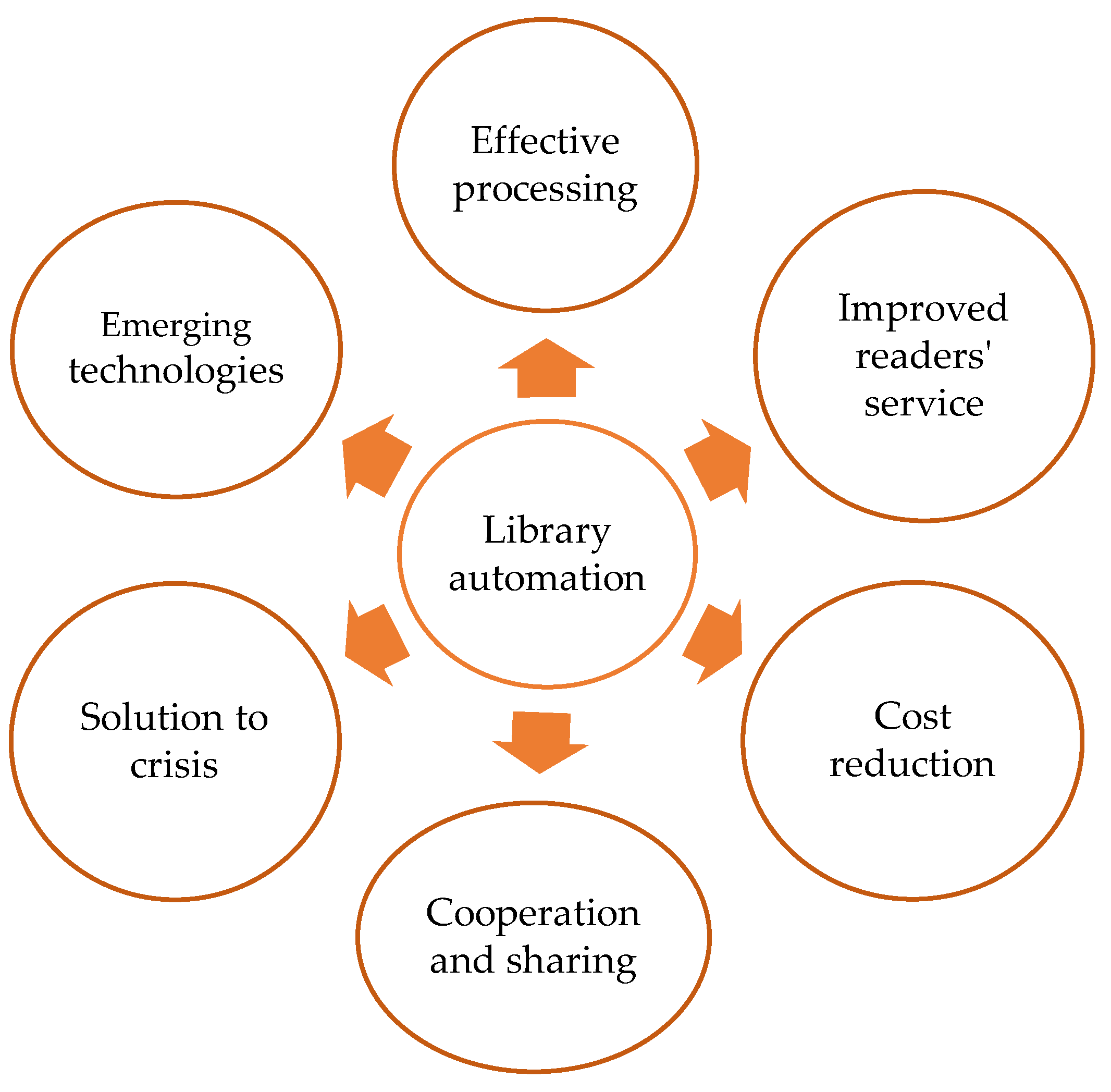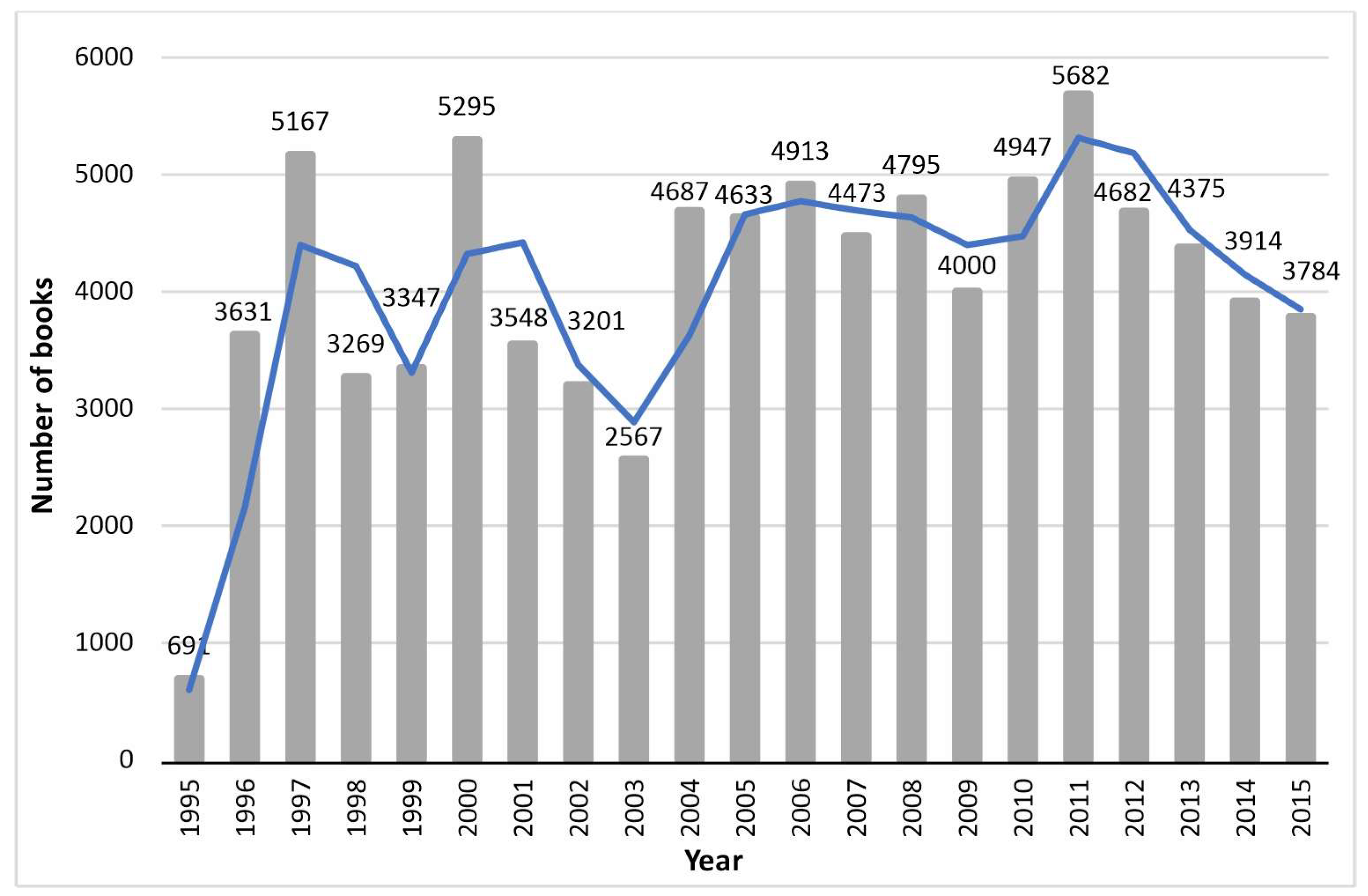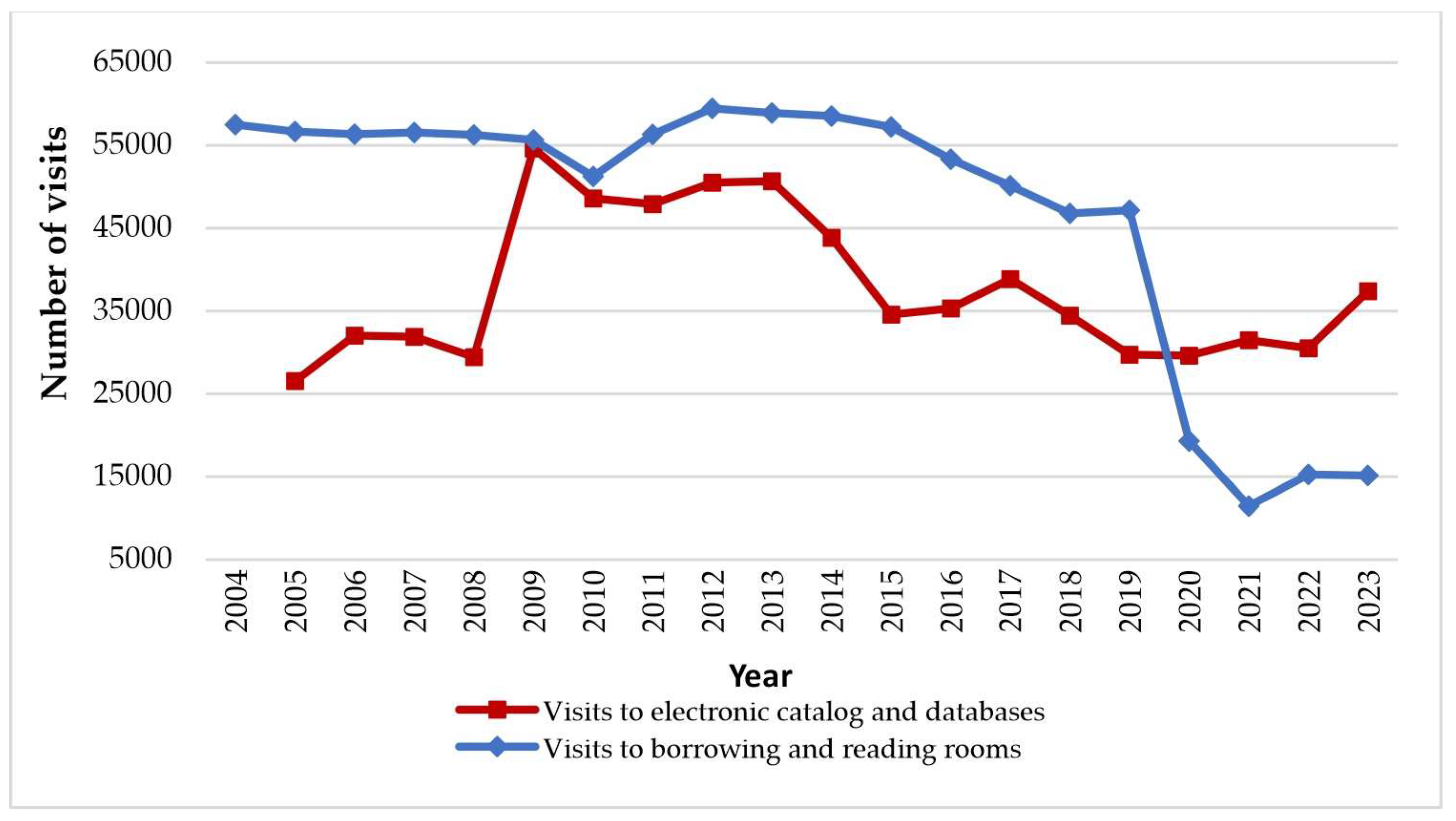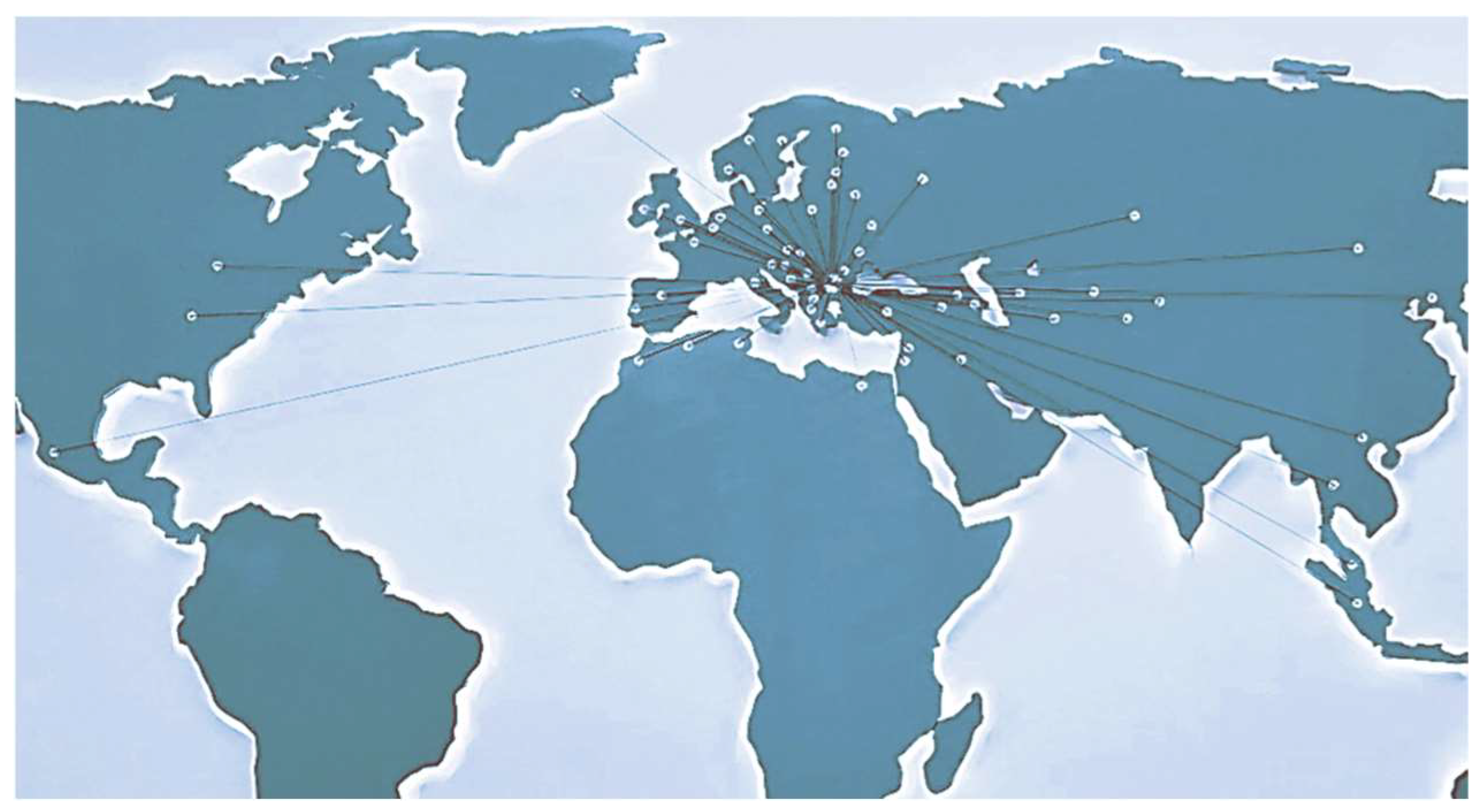Automation of Library Services—Turning Point in Development of Academic Libraries †
Abstract
1. Introduction
2. Methods
2.1. Origin and Purposes of Library Automation
- More effective processing. Automation provides flexibility in the access and sorting of individual files. Additionally, it makes activities like acquisition, cataloging, and processing less labor-intensive and space-demanding.
- Improved service to library users. The essential advantage of automation in libraries is improved service for users. Fast cataloging and easier search through abstracting and indexing allow for more focused use of the library.
- Reduction of costs. The widespread assumption that automation and computerization will eliminate many manual tasks is true. However, time has proven that the money and time saved with automation lead to the emergence of new tasks and the demand for further personnel qualifications.
- Resource sharing and library cooperation. Through cooperation and the combining of finances, some libraries, at first in the USA and then in Canada, created consortiums. This allowed them to introduce automation technologies and share resources between partners.
- Response to a need (crisis). Automation was a natural solution to a breakdown in manual services, chaos, and the urgent need for correct reporting and analysis of library information and services. One of the basic reasons for implementing automation is the need to reorganize or create new work patterns or structures in libraries.
- Automation due to emerging technologies. As libraries play crucial roles in information access and modern society, it is important to adapt and use new technologies. This is a way to attract and keep the attention of a young and innovative society.
2.2. Technologies and Stages of Library Automation
- Pre-computer era. During this period, an electromagnetic system was used, called the unit-record system. Information was inserted onto a punched card and reused afterward for calculations.
- Offline computerization. This stage took place in the 1960s and was characterized by major developments in technology. The transactions were not recorded on the computer, where they were produced, but collected and processed collectively in a so-called “batch mode”. Punched cards and patron identification cards were used in this process. The daily library statistics, for example, were gathered and then collectively calculated at the end of the working day.
- Online computerization. The early 1970s were characterized by a few remarkable changes. One is the establishment of large-scale online interactive systems between different universities. Another is the emergence of commercially available online library systems due to the emergence of microcomputers. Finally, the first attempt at a truly integrated system, combining all library activities, was realized in the 1970s with NOTIS.
- Microcomputers. The major technological developments include microcomputers, introduced in the early 1980s. Their significance for library automation can be summarized by three main points. Microcomputers made it possible for smaller libraries to possess their own machines. Microcomputers perform some autonomous activities, which allows the decentralization and distribution of tasks within the library. Finally, microcomputers execute administrative everyday tasks like word processing, budgeting, accounting, and so on.
- COM and CD-ROM. These devices store data and present it. Later, some database products started to offer “site licensing”. In this way, libraries could store information on their local system for a fixed price instead of using intermediary devices.
- Communication technologies. At first, communication technologies like system teletype or TWX machines were used to manage interlibrary loans. Later, fax transmission machines were used to deliver full-text articles between libraries. In the 1990s, the Internet emerged, and it changed how information is searched for, managed, and shared.
2.3. Chronology and Characteristics of Automation in Bulgarian Academic Libraries
3. Results
3.1. Characteristics and Chronology of Automation in the “Angel Kanchev” University of Ruse, Bulgaria
3.2. Management and Functioning Effects of the Library Automation in “Angel Kanchev” University of Ruse, Bulgaria
- More effective processing. Immediately after the Automated Library product was introduced, the computer processing of different kinds of volumes (periodicals, books, dissertations, conference proceedings, etc.) began. The technology used for that consisted of three computers and one server. As a result, at the end of 2015, the number of books in the electronic catalog was 137,062. In total, 85,601 of them were acquired and processed annually during the period of 1995–2015. Another 51,461 volumes were additionally processed in order to insert previously acquired literature into the system.
- Improved service to library users. The modernization and development of the university library are connected with the development of new types of spaces and the restructuring and reorganization of library funds. The increase in the amount of literature available for free access makes readers feel more comfortable and connected with all information materials. The introduction of RFID technologies makes service faster. Users are registered electronically; they do not have to give personal information by hand, and any borrowed books are taken and returned with just one click on the RFID tag. Additionally, the new system better secures the information materials and protects the library facilities [15].
- Response to a need (crisis). With the development of the university and the increase in its educational capacity, new specialties and faculties are created. This leads to an increase in the number of students and an expansion of the library fund. In 2010, a new part of the library was established in another building. The automation system made the process of managing and coordinating between the different branches more precise and less time-consuming. Daily reports of the work are automatically produced; there is no need for a librarian to collect and calculate numbers.
- Reduction of costs. The infrastructure and technology needed for the automation of libraries require a large investment, which proves its cost efficiency over time. After the library’s automation, the amount of paper used decreased; most of the documents, reports, and the entire catalog are now electronic. The number of highly qualified experts in the traditional library sciences is decreasing because management and circulation are greatly simplified by automated systems. The profile of librarians is changing with time and technology. Presently, they develop their information literacy daily and continuously learn how to gather and interpret data from online sources. Information specialists from this library regularly participate in online courses and professional development activities in order to learn about the latest functionalities and improvements in electronic services. The number of educational activities completed by librarians from the University of Ruse during the period of 2020–2023 is 11. In comparison, in the previous period, between 2017 and 2020, this number was 4, which shows a rise in the need for qualification activities. A great part of our everyday duties is the creation and management of digital repositories and the subscription and lending of online resources. For example, at the University of Ruse, the publication activity of the academic staff in international journals with high impact is monitored on a monthly basis. It is then submitted to the management team for further analysis and planning.
- Resource sharing and library cooperation. Since 2009, the university library has been part of the common catalog of the National Academic Library and Information System [15]. Additionally, since 2008, through participation in the Bulgarian Information Consortium [16], subscriptions to various online databases and online resources have been cheaper and shown greater variety. Interlibrary exchanges and searches of information resources in partner universities are faster and simpler after automation.
- Automation due to emerging technologies. The university library continuously introduces innovative solutions. In 2021, the library’s system was connected to the university program “Student”. It makes it possible to upload electronic dossiers of new users directly into the “Readers” module in the library. This makes registering and servicing faster and more accurate; 2008 newcomers have been registered automatically since the connection of the systems. In 2022, a new version of the software was created, and the catalog is now accessible through the internet and available to readers worldwide. Users can conduct their search at home and afterwards contact the information specialist, if necessary. The “My library” module was added, which enables students to check their status and obligations. The data of the library are placed on a virtual server, thereby providing new opportunities for information processing, including work with scanned documentation. Digitalization at the library started with two projects. With the first project, the library acquired a [17] book scanner. The oldest book collection (dating from 1986–1922) was scanned and made available in the catalog. Students from the pedagogical specialties used the scanned versions of the books for analysis in their education, while the originals were preserved. With the second project [17], the university library digitized the archive containing the work of the Academic Council, produced during the period of 1954–2001. The managing body of the university made fast references, and the history of the university was preserved.
4. Discussion
5. Conclusions
- The digitization of library services and more complete use of information resources, as well as new technologies for the development of education, science, and innovation.
- Transforming the means of providing information materials and transitioning to an AI library.
Funding
Institutional Review Board Statement
Informed Consent Statement
Data Availability Statement
Conflicts of Interest
References
- Brown, J.S. Changing How We Think About and Lead Change. In Library Workforce for 21st Century Research Libraries; Association of Research Libraries: Washington, DC, USA, 2012. [Google Scholar]
- Revez, J. Opening the Heart of Science: A Review of the Changing Roles of Research Libraries. Publications 2018, 6, 9. [Google Scholar] [CrossRef]
- Research Libraries UK. Powering Scholarship: RLUK Strategy 2014–17; Research Libraries UK: London, UK, 2014. [Google Scholar]
- Association of Research Libraries. Strategic Thinking and Design Initiative: Extended and Updated Report; Association of Research Libraries: Washington, DC, USA, 2016. [Google Scholar]
- LIBER. Research Libraries Powering Sustainable Knowledge in the Digital Age: LIBER Europe Strategy 2018–2022; LIBER: The Hague, The Netherlands, 2017. [Google Scholar]
- Carlson, J.; Kneale, R. Embedded librarianship in the research context: Navigating new waters. Coll. Res. Libr. News 2011, 72, 167–170. [Google Scholar] [CrossRef]
- Vandegrift, M. Designing Digital Scholarship Ecologies. Available online: https://osf.io/preprints/lissa/93zvb (accessed on 6 June 2024).
- 2nd Global Research Library 2020. Paving the Way for a Collaborative Global Research Environment: Outcomes of GRL2020 Europe; GRL2020: Pisa, Italy, 2008. [Google Scholar]
- Kozareva, B. Indicators for Research of Users’ Information Behaviour in University Libraries in Bulgaria; Avangard Prima: Sofia, Bulgaria, 2023; ISBN 9786192399436. [Google Scholar]
- Simons, M. Academic Library Metamorphosis and Regeneration; Rowman & Littlefield Publishers: Lanham, MD, USA, 2018; ISBN 9781442273085. [Google Scholar]
- Yavrukova, B. Development of Bulgarian Toolkit for Building Library-Information Services; Publishing House Sofia University “St. Kliment Ohridski”: Sofia, Bulgaria, 2022; ISBN 9789540754178. [Google Scholar]
- Americal Library Association. World Encyclopaedia of Library and Information Sciences, 3rd ed.; American Library Association: Chicago, IL, USA, 1993; ISBN 0838906095. [Google Scholar]
- McClain, J. Information Technology and Library: Managing Transformative Library Services; Society Publishing: Oakville, ON, Canada, 2019; ISBN 978177361978-1. [Google Scholar]
- University of Ruse. Guidebook; University of Ruse: Ruse, Bulgaria, 1974. [Google Scholar]
- National Academic Library-Information System. NALIS Union Catalogue. Available online: https://unicat.nalis.bg/ (accessed on 6 June 2024).
- Bulgarian Information Consortium. Shared Subscriptions for Electronic Information Resources. Available online: https://bic.bg/uslugi/ (accessed on 6 June 2024).
- Atanasova, D. Creating a Digital Collection in the Fund of the University Library in University of Ruse Angel Kanchev; Publishing House at University of Ruse “Angel Kanchev”: Ruse, Bulgaria, 2023. [Google Scholar]
- Bulgarian Information Consortium. Forum: Biblioworld 2024: For Modern Bulgarian Libraries; Technical University: Sofia, Bulgaria, 2024. [Google Scholar]
- EBSCO. Artificial Intelligence. Available online: https://www.ebsco.com/technology/artificial-intelligence-ai (accessed on 1 June 2024).
- ExLibris. Artificial Intelligence Blog Series: Introducing Our AI Generated Metadata. Available online: https://exlibrisgroup.com/blog/artificial-intelligence-blog-series-introducing-our-ai-metadata-generator/ (accessed on 9 May 2024).
- Kluwer, W. A Unified Discovery and Delivery Platform Focused and Specialized in Biomedical Content. Available online: https://tools.ovid.com/oviddiscovery/ (accessed on 9 May 2024).
- European Commission. Erasmus+, EU Programme for Education, Training, Youth and Sport. Available online: https://erasmus-plus.ec.europa.eu/bg (accessed on 10 May 2024).
- University of Ruse. Erasmus Mobility. Available online: https://erasmus.uni-ruse.bg/en/?cmd=cmsPage&pid=26 (accessed on 10 May 2024).
- University of Ruse. International Cooperation. Available online: https://www.uni-ruse.bg/en/international/partnership (accessed on 3 May 2024).
- European Union. EU Countries, Bulgaria. Available online: https://european-union.europa.eu/principles-countries-history/eu-countries/bulgaria_en (accessed on 3 May 2024).
- European Union. Contact the EU. Available online: https://european-union.europa.eu/contact-eu/meet-us_en?networks=EDC (accessed on 2 May 2024).
- Francis, A.T. Teaching Role of Librarians; Daya Pub. House: Kerala, India, 2018; ISBN 978-9388173087. [Google Scholar]






Disclaimer/Publisher’s Note: The statements, opinions and data contained in all publications are solely those of the individual author(s) and contributor(s) and not of MDPI and/or the editor(s). MDPI and/or the editor(s) disclaim responsibility for any injury to people or property resulting from any ideas, methods, instructions or products referred to in the content. |
© 2024 by the author. Licensee MDPI, Basel, Switzerland. This article is an open access article distributed under the terms and conditions of the Creative Commons Attribution (CC BY) license (https://creativecommons.org/licenses/by/4.0/).
Share and Cite
Ivanova, V. Automation of Library Services—Turning Point in Development of Academic Libraries. Eng. Proc. 2024, 70, 38. https://doi.org/10.3390/engproc2024070038
Ivanova V. Automation of Library Services—Turning Point in Development of Academic Libraries. Engineering Proceedings. 2024; 70(1):38. https://doi.org/10.3390/engproc2024070038
Chicago/Turabian StyleIvanova, Viktoriya. 2024. "Automation of Library Services—Turning Point in Development of Academic Libraries" Engineering Proceedings 70, no. 1: 38. https://doi.org/10.3390/engproc2024070038
APA StyleIvanova, V. (2024). Automation of Library Services—Turning Point in Development of Academic Libraries. Engineering Proceedings, 70(1), 38. https://doi.org/10.3390/engproc2024070038





